Recent Articles
Popular Makes
Body Types
2022 Ford Escape PHEV Road Test and Review

2022 Ford Escape PHEV ・ Photo by Ron Sessions
For those buyers who like the idea of an electric vehicle but worry about running out of electric range and enduring long charging times, there’s the plug-in hybrid or PHEV. Popular entries in the compact SUV PHEV space include the Toyota RAV4 Prime, the Hyundai Tucson, and the subject of this review, the Ford Escape PHEV.
Three years into its current design, the 2022 Ford Escape’s sleek and curvaceous lines remain easy on the eyes. Low and wide with styling cues from the departed Ford Fusion sedan and a dash of Porsche Macan, the third-generation Escape leaves the chunkier, more rugged off-road look to other entries such as its Bronco Sport stablemate.
With the new Escape, Ford is looking to attract city and suburban dwellers seeking a stylish and energy-efficient compact crossover with good passenger and cargo versatility that’s easy to maneuver and park in an urban setting. The plug-in hybrid version of the Escape delivers on all counts.
Including the $1,245 destination charge, the 2022 Ford Escape plug-in hybrid is available in $35,235 base SE, $37,920 midlevel SEL, and $40,430 range-topping Titanium trim. All plug-in hybrid models are equipped with front-wheel drive.
For the 2022 model year, the Escape PHEV qualifies for $6,843 of the $7,500 federal tax credit.
Hybrid Powertrain
In addition to two gas engines — a 181-hp 1.5-liter EcoBoost 3-cylinder turbo and a 250-hp 2.0-liter EcoBoost 4-cylinder turbo — the 2022 Escape is available as a conventional or plug-in hybrid. Both hybrids blend the urgings of a somewhat grainy non-turbo 165-hp 2.5-liter 4-cylinder and electric drive motor with an electronic continuously variable transmission. Total conventional hybrid system output is 221 hp.
The main difference is the plug-in version has a larger 14.4 kWh lithium-ion battery and system controls that allow it to drive up to 37 miles solely on electric power. No hot rod, the Escape plug-in can accelerate from rest to 60 mph in just under 9 seconds. By comparison, the RAV4 Prime can zoom from zero to 60 mph in less than 6 seconds. The Escape PHEV’s acceleration and brake response are smooth and linear, not the two-step experience found in some other hybrids.
The big draw here for the Escape PHEV is its efficiency. The EPA gives it a 105 MPGe overall rating, topping the 94 MPGe of the Toyota RAV4 Prime and 80 MPGe of the Hyundai Tucson PHEV. The MPGe rating takes into account the all-electric range of the plug-in versions. According to the EPA, the Escape PHEV is also more efficient than its competitors when the gas engine and electric motor are both providing propulsion, with the Escape PHEV city/highway combined rating at 40 mpg, topping the RAV4 Prime’s 38 mpg and Tucson PHEV’s 35 mpg.
I observed 37.7 average mpg on the Escape’s trip computer in a week of mixed city/suburban/interstate/rural two-lane driving.
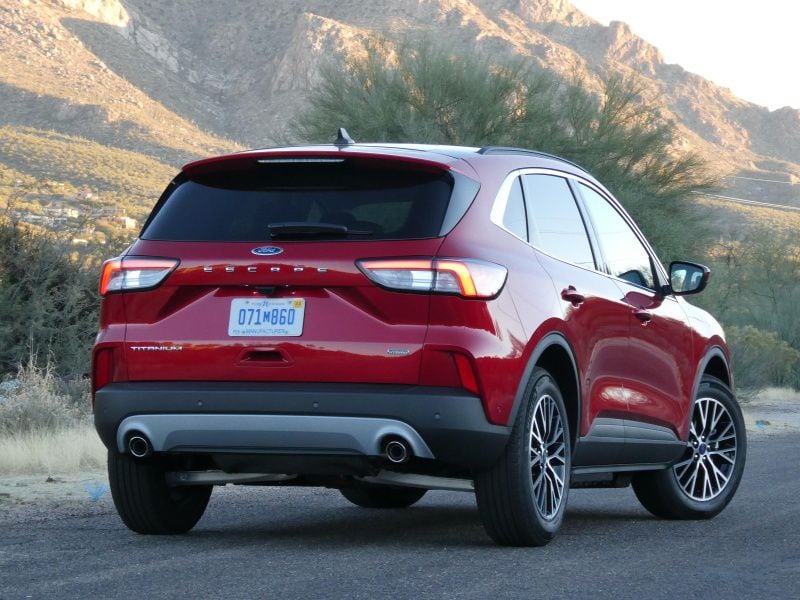
Photo by Ron Sessions
Plugging In
Speaking of plugging in, topping off the 14.4 kWh lithium-ion hybrid battery on a semi-regular basis allows the Escape PHEV buyer to power the compact SUV solely on electrons for short commutes and local errands without worrying about running out of range. If a local trip exceeds the 37 miles or so of electric-only range, the plug-in starts acting like a conventional gas-electric hybrid, with the engine keeping the hybrid battery charged up to power the electric drive motor that works in conjunction with the 2.5-liter gas powerplant.
Charging up at home is easy. With a standard 110-volt wall outlet, one can recharge the plug-in hybrid’s battery overnight in just over 11 hours. Install a Level-two 220-volt charger in your garage and charge time drops to 3.3 hours.
The Escape PHEV driver can choose how to use the Escape’s fully charged hybrid battery by accessing settings in the center screen. In Auto EV mode, the vehicle determines how best to use the available charge for best efficiency. EV Now mode switches off the gas engine until the 37 miles or so of usable electric range is depleted. EV Later conserves battery power for a later time, and EV Charge keeps the engine charging and hybrid battery topped off at all times.
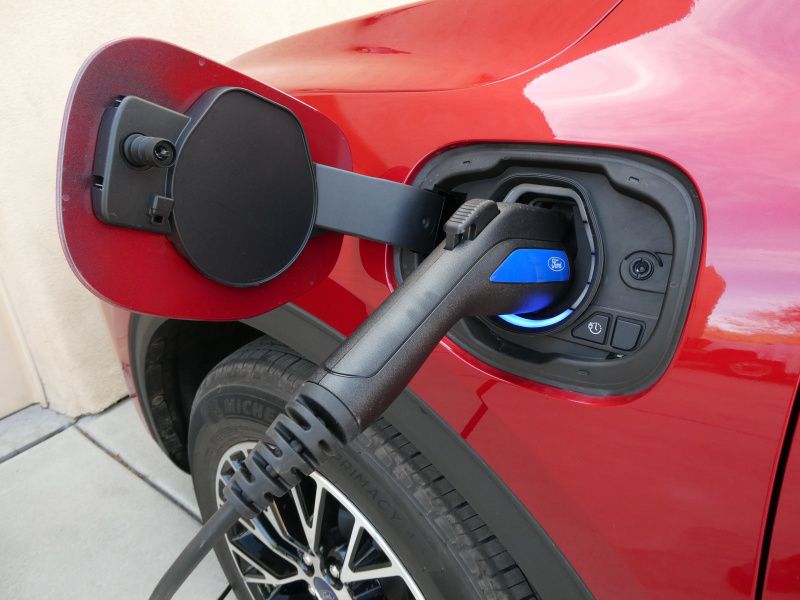
Photo by Ron Sessions
Roomy Interior
The Escape’s cabin is roomy with decent storage for small items and road-trip detritus. As with the exterior, the interior design layout is attractive and modern. However, lots of hard plastic surfaces let the buyer know this is a lower-priced offering in Ford’s SUV hierarchy. In higher trims such as the Titanium test vehicle, however, there are attractive two-tone color schemes with a more premium feel.
The interior is hushed courtesy of extensive soundproofing, an isolated rear suspension cradle, and noise-reducing acoustic glass for the windshield and front doors, although coarse pavement sets up a hollow sound inside. An active noise-cancellation system working through the Escape’s audio speakers keeps engine sound at bay.
Standard fare on all models includes set-and-forget dual-zone automatic climate control, regular cruise control, a tilt-telescope steering wheel, and a 6.5-inch color LCD driver’s display. The SEL trim adds remote engine start, a Securicode door-post keypad entry, express up/down power windows, and a heated steering wheel, while the Titanium trim brings ambient interior lighting, an auto-dimming rearview mirror, a universal garage-door opener, and a driver-configurable 12.3-inch digital gauge display. A panoramic sunroof is an option.
A wireless cellphone charger in the forward bin of the console is optional in the SEL and Titanium trims. Also optional is a Mazda-like 6-inch head-up display on a plastic screen atop the gauge binnacle that can be configured to relay vehicle speed, driver-assist status, navigation, and detail on incoming calls.
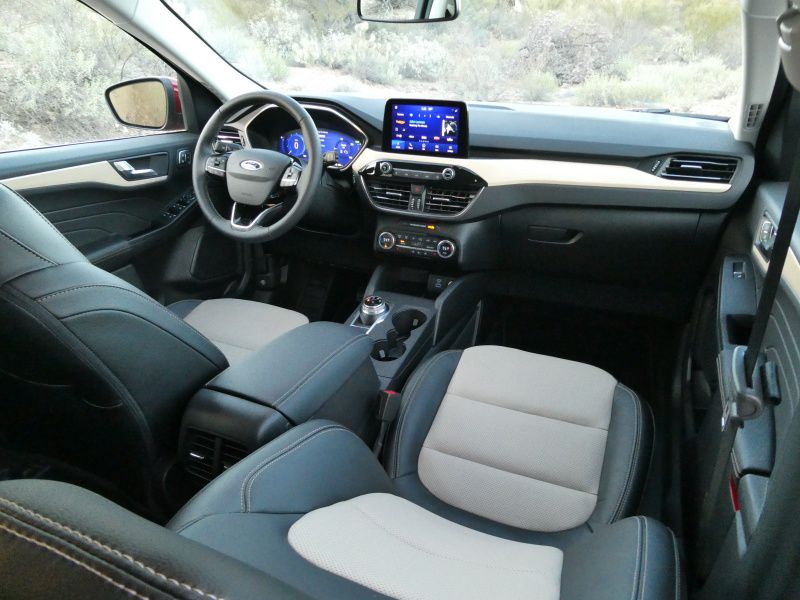
Photo by Ron Sessions
Sync3 Infotainment and Connectivity
The standard system in the Escape plug-in hybrid is simple to use, featuring a landscape-format 8-inch capacitive touchscreen with vibrant colors and large, easy-to-select-on-the-fly screen tiles. Directly below the screen are handy analog knobs for adjusting volume and tuning plus hard buttons for seek, scan and other frequently used functions. There are also steering wheel buttons for volume and station selection, and all Escape plug-in trims come with advanced voice control standard. The system is (wired) Apple CarPlay and Android Auto compatible. For connectivity, there is one USB-A and one of the faster USB-C smart charge ports in the console.
Ford CoPilot 360 Assist+, standard in Titanium and optional in SE and SEL, adds voice-activated navigation with pinch to zoom, SiriusXM Traffic, and Travel Links. A voice request to find the nearest Walmart was successful, but the system flubbed another to locate the nearest Office Depot just down the street.
Standard Escape plug-in hybrid audio fare is a simple 6-speaker AM/FM with a 3-month trial of SiriusXM. A subwoofer-bolstered 10-speaker B&O premium system and HD Radio are optional. 4G Wi-Fi is onboard as well with the customer’s active data plan courtesy of the standard Ford PassConnect system. The Wi-Fi can handle as many as 10 devices within 50 feet of the dash, great for the next tailgate party.

Photo by Ron Sessions
Front Seats
Although the lower cushions of the Escape’s front bucket seats are on the short side for long-legged passengers, the front perches offer good all-around comfort for drives both long and short. The basic, cloth-covered, manually adjusted buckets of the SE trim upgrade to more highly contoured, heated sport seats with torso-hugging lower backrests in SEL models. The SEL adds an 8-way power-adjusted driver’s seat with power lumbar adjustment and stain-resistant, synthetic ActiveX seat coverings. Moving up to Titanium grade nets a 6-way power front passenger seat, ups the power driver’s seat to 10-way adjustment, and adds a driver’s seat memory function. Leather seat trim is also available with Titanium trim at extra cost in an optional Titanium Premium package.
Getting in and out is easy as the Escape step-in height is more akin to that of a station wagon or crossover than a rugged SUV. Overall, Escape front-seat legroom is among the best in the compact SUV segment.

Photo by Ron Sessions
Flexible Rear Seat
Most compact SUVs and crossovers feature a standard fold-down rear bench seat with 60/40 split seatbacks to enable owners to carry a rear-seat passenger or two on one side and longer or greater amounts of cargo on the other. But the Escape takes this one step further with bottom cushions that slide fore and aft up to a half foot to further customize the rear seat space with more legroom on one side to accommodate taller passengers while the other side can be left in a more forward position to extend cargo floor length behind a raised rear seatback. SEL and Titanium trims add a fold-down rear-seat center armrest with a pair of cup holders. Overall, rear-seat space is more generous in the Escape plug-in hybrid than in the Toyota RAV4 Prime.
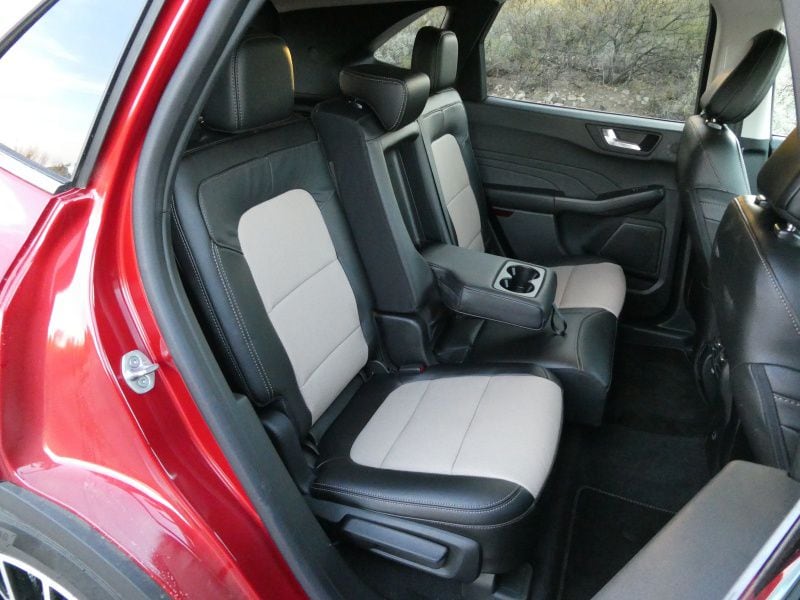
Photo by Ron Sessions
Cargo Considerations
One the major reasons buyers choose crossovers and SUVs over sedans is cargo space. In the compact SUV realm, the Escape plug-in hybrid doesn’t offer as much room for cargo as its Toyota RAV4 Prime or Hyundai Tucson plug-in hybrid competitors thanks to the Ford’s lower, swoopier shape, but still has plenty for most owner’s needs. With the 60/40 split rear seat upright and in its most forward position, there’s 34.4 cubic feet of cargo space in the Escape plug-in hybrid. When the rear seat is folded down, that expands to 60.8 cubic feet.
Because the Escape has a spare tire well under the cargo floor but comes standard with just a portable tire inflator and sealant kit, there’s abundant room under the cargo floor to hide valuables such as a computer, camera bag, or purse away from prying eyes if the optional mini spare tire isn’t ordered. Optional is a cargo area shade and a dealer-installed cargo organizer.
Access to the cargo hold is via a manual lift gate with SE trim, a power-operated one in the SEL, or a hands-free, power lift gate that opens with a foot wave under the rear bumper (if the key fob is nearby) on the Titanium version.

Photo by Ron Sessions
Safety and Driver-Assistive Tech
Keeping pace in a very competitive segment, the 2022 Escape comes standard with Ford CoPilot360 which includes forward collision warning with automatic emergency braking and pedestrian detection, lane-departure warning and lane-keeping systems, blind-spot and rear cross-traffic monitoring, a basic backup camera, post-collision braking, and automatic high beams. The next step up is Ford CoPilot360 Assist+, optional on Escape SE and SEL, which adds adaptive cruise control with lane centering and evasive steering assist as well as speed-sign recognition.
Parking aids include a rear parking sensor on SEL and both front and rear parking sensors on the Titanium. Escape Titanium models are available with Active Park Assist 2.0 which can parallel park an Escape without throttle, steering, gearshift, or brake intervention once the driver pushes and holds the park assist button and driven past the parking spot in question.
The National Highway Traffic Safety Administration did not rate the 2022 Escape PHEV but gave all other versions of the compact SUV five out of five stars for crashworthiness. The Insurance institute for Highway Safety also did not rate the 2022 Escape for crashworthiness, but the 2021 version was an IIHS Top Safety Pick.
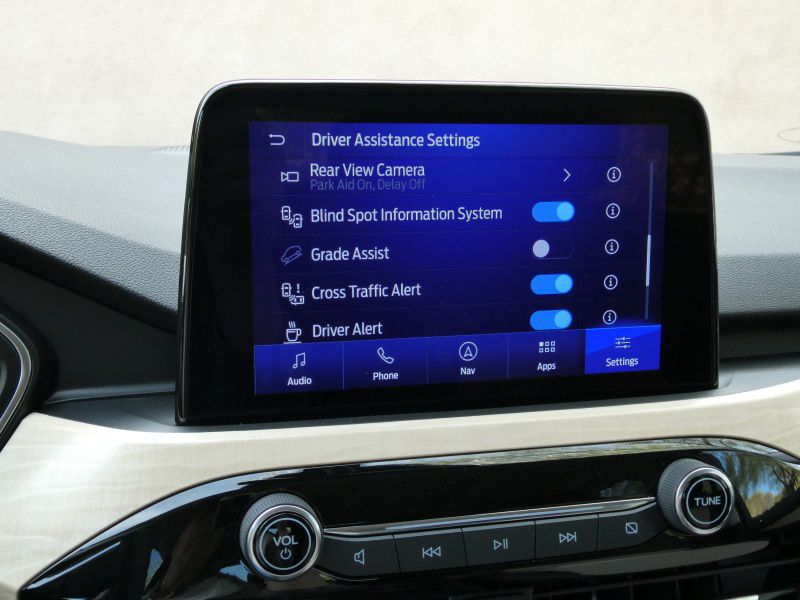
Photo by Ron Sessions
Zero Range Anxiety
With sleek styling, a roomy cabin, impressive fuel economy, and the latest Ford infotainment and driver-assistive technology, the plug-in hybrid version of the Escape compact crossover suv provides a pathway for buyers to dip a toe in the electric vehicle space without the twin spectres of range anxiety and lengthy charging hassles. The beauty of the Ford Escape PHEV is its ability to function as an electric runabout for local driving and a high-mpg gas-powered hybrid for longer drives without the need to recharge enroute.
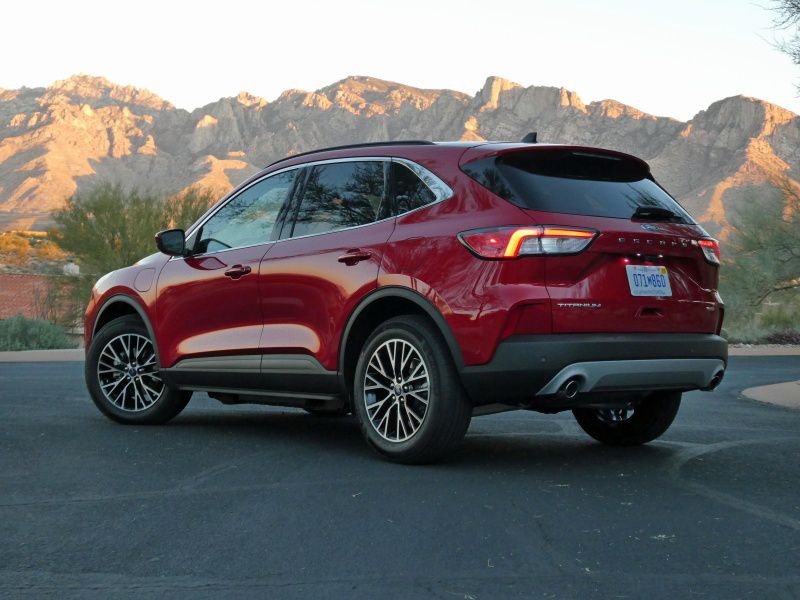
Photo by Ron Sessions